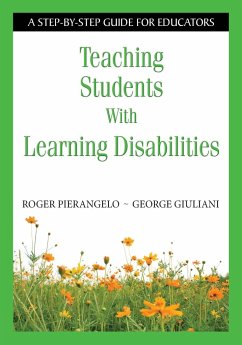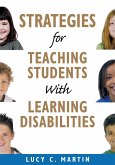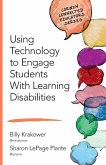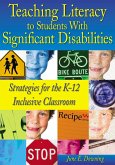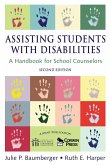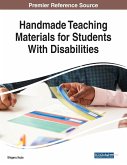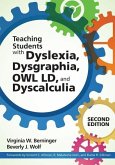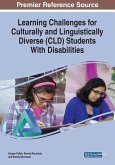Roger Pierangelo, George Giuliani
Teaching Students With Learning Disabilities
A Step-by-Step Guide for Educators
Roger Pierangelo, George Giuliani
Teaching Students With Learning Disabilities
A Step-by-Step Guide for Educators
- Broschiertes Buch
- Merkliste
- Auf die Merkliste
- Bewerten Bewerten
- Teilen
- Produkt teilen
- Produkterinnerung
- Produkterinnerung
The authors include a complete glossary of terms, plus guidelines for academic instruction, behavioral interventions, classroom accommodations, placement options, assessments, and transition services for students with LD.
Andere Kunden interessierten sich auch für
![Strategies for Teaching Students with Learning Disabilities Strategies for Teaching Students with Learning Disabilities]() Lucy C. MartinStrategies for Teaching Students with Learning Disabilities37,99 €
Lucy C. MartinStrategies for Teaching Students with Learning Disabilities37,99 €![Using Technology to Engage Students With Learning Disabilities Using Technology to Engage Students With Learning Disabilities]() Billy KrakowerUsing Technology to Engage Students With Learning Disabilities14,99 €
Billy KrakowerUsing Technology to Engage Students With Learning Disabilities14,99 €![Teaching Literacy to Students with Significant Disabilities Teaching Literacy to Students with Significant Disabilities]() June E DowningTeaching Literacy to Students with Significant Disabilities37,99 €
June E DowningTeaching Literacy to Students with Significant Disabilities37,99 €![Assisting Students with Disabilities Assisting Students with Disabilities]() Julie P. BaumbergerAssisting Students with Disabilities31,99 €
Julie P. BaumbergerAssisting Students with Disabilities31,99 €![Handmade Teaching Materials for Students With Disabilities Handmade Teaching Materials for Students With Disabilities]() Handmade Teaching Materials for Students With Disabilities137,99 €
Handmade Teaching Materials for Students With Disabilities137,99 €![Teaching Students with Dyslexia, Dysgraphia, Owl LD, and Dyscalculia Teaching Students with Dyslexia, Dysgraphia, Owl LD, and Dyscalculia]() Virginia W BerningerTeaching Students with Dyslexia, Dysgraphia, Owl LD, and Dyscalculia50,99 €
Virginia W BerningerTeaching Students with Dyslexia, Dysgraphia, Owl LD, and Dyscalculia50,99 €![Learning Challenges for Culturally and Linguistically Diverse (CLD) Students With Disabilities Learning Challenges for Culturally and Linguistically Diverse (CLD) Students With Disabilities]() Soraya FallahLearning Challenges for Culturally and Linguistically Diverse (CLD) Students With Disabilities162,99 €
Soraya FallahLearning Challenges for Culturally and Linguistically Diverse (CLD) Students With Disabilities162,99 €-
-
-
The authors include a complete glossary of terms, plus guidelines for academic instruction, behavioral interventions, classroom accommodations, placement options, assessments, and transition services for students with LD.
Hinweis: Dieser Artikel kann nur an eine deutsche Lieferadresse ausgeliefert werden.
Hinweis: Dieser Artikel kann nur an eine deutsche Lieferadresse ausgeliefert werden.
Produktdetails
- Produktdetails
- Verlag: Corwin
- Seitenzahl: 192
- Erscheinungstermin: 29. Mai 2008
- Englisch
- Abmessung: 254mm x 178mm x 11mm
- Gewicht: 373g
- ISBN-13: 9781412916011
- ISBN-10: 1412916011
- Artikelnr.: 23430631
- Verlag: Corwin
- Seitenzahl: 192
- Erscheinungstermin: 29. Mai 2008
- Englisch
- Abmessung: 254mm x 178mm x 11mm
- Gewicht: 373g
- ISBN-13: 9781412916011
- ISBN-10: 1412916011
- Artikelnr.: 23430631
Roger Pierangelo is an associate professor in the Department of Special Education and Literacy at Long Island University. He has been an administrator of special education programs and served for eighteen years as a permanent member of Committees on Special Education. He has over thirty years of experience in the public school system as a general education classroom teacher and school psychologist, and is a consultant to numerous private and public schools, PTAs, and SEPTA groups. Pierangelo has also been an evaluator for the New York State Office of Vocational and Rehabilitative Services and a director of a private clinic. He is a New York State licensed clinical psychologist, certified school psychologist, and a Board Certified Diplomate Fellow in Child and Adolescent Psychology and Forensic Psychology. Pierangelo is currently president of The National Association of Special Education Teachers, executive director of The American Academy of Special Education Professionals, and vice-president of The National Association of Parents with Children in Special Education. Pierangelo earned his BS degree from St. John¿s University, his MS from Queens College, Professional Diploma from Queens College, PhD from Yeshiva University, and Diplomate Fellow in Child and Adolescent Psychology and Forensic Psychology from the International College of Professional Psychology. He is a member of the American Psychological Association, New York State Psychological Association, Nassau County Psychological Association, New York State Union of Teachers, and Phi Delta Kappa. Pierangelo is the coauthor of numerous books, including The Big Book of Special Education Resources and The Step-by-Step Book Series for Special Educators.
Dedications
About the Authors
Preface
1. Overview of Learning Disabilities
IDEA Definition of a Specific Learning Disability
Overview of Specific Learning Disabilities
Key Facts About Learning Disabilities
Causes of a Specific Learning Disability
Age of Onset for Specific Learning Disabilities
Gender Features for Specific Learning Disabilities
Cultural Features for Specific Learning Disabilities
Familial Patterns for Specific Learning Disabilities
Co-morbidity for Specific Learning Disabilities
Discrepancy in Diagnosing a Learning Disability
The Exclusionary Clause
Characteristics of Specific Learning Disabilities
Educational Implications of Specific Learning Disabilities
2. Characteristics of Children With Learning Disabilities
Overview
Academic Achievement Deficits
Language Deficits
Disorders of Attention
Achievement Discrepancy
Memory Deficits
Cognitive Deficits
Metacognition Deficits
Social-Emotional Problems
Nonverbal Learning Disorders (NLD)
Motivational and Attribution Problems
Perceptual Deficits
3. Types of Learning Disabilities
Auditory Processing Disorders
Dyscalculia (Arithmetic Disorder)
Dysgraphia (Writing Disorders)
Dyslexia (Reading Disorders)
Dysorthographia (Spelling Disorders)
Nonverbal Learning Disabilities (Nonverbal Learning Disorders or NLD)
Organizational Learning Disorders
Social Cue Disorder
Visual Processing Disorders
4. Eligibility Criteria for Learning Disabilities
Step I. Becoming Familiar With the Characteristics of Students With
Specific Learning Disabilities
Step II. Determining the Procedures and Assessment Measures To Be Used
Step III. Determination of Eligibility for a Diagnosis of a Specific
Learning Disability
5. Responsiveness to Intervention (RTI)
Overview of Responsiveness to Intervention (RTI)
Purpose of RTI
Importance of RTI
Is RTI a New Approach?
Core Principles of RTI
Rationale for Replacing the Discrepancy Model With RTI
Major Issues Related to the Use of the Concept of Achievement-Ability
Discrepancy
Why RTI Was Considered in the Process of SLD Determination
The Role RTI Should Play in the Identification of Children With Specific
Learning Disabilities
Can RTI Be Used as the Sole Determinant for SLD Classification?
In the Big Picture, How Does RTI Fit Into the Determination of LD Process?
Continuum of Intervention Support for At-Risk Students
Parent Involvement, An Important Component for Successful RTI Programs
Fidelity
The RTI Process for Teachers
What Teachers Need in Terms of Professional Development and RTI
6. Effective Teaching Strategies for Students With LD
Academic Instruction
Behavioral Interventions
Classroom Accommodations
7. Promoting Positive Social Interactions Among Students With and Without
Learning Disabilities in an Inclusion Setting
Introduction
Review of Inclusion
Principles of Effective Inclusion
Why Are Social Skills Important?
Social-Cognitive Skill Development
The Role of Social Skills at School
Strategies to Foster a Sense of Belonging in the Inclusion Classroom
Creating a Positive Inclusion Classroom Climate
Teaching Social Skills Through Role-Playing and Observation
The Inclusion Classroom Teacher¿s Power to Model Acceptance
Promoting Positive Social Interactions Among Students With and Without
Learning Disabilities in an Inclusion Setting
8. IEP Development and Educational Placement Options for Students With
Learning Disabilities
Overview of the IEP Committee
Members of the IEP Committee
Responsibilities of the IEP Committee
IDEA 2004 and IEP Committee Meeting: What to Know
Development of the Information Packet for Presentation to the IEP Committee
Required Forms
How Recommendations for Classification Are Made by the IEP Committee
Specific Educational Placement (LRE) Considerations According to IDEA 2004
Appealing the Decision of the IEP Committee
Other Roles of the IEP Committee
IEP Development
Components to Be Included in the IEP
Questions and Answers About the IEP Under IDEA 2004
9. Transition Services for Students With Learning Disabilities
The Transitional Process
The Intent of Transition Services
The Importance of Transition Services for Individuals With Learning
Disabilities
The Introduction of Transition Services
The Individualized Transition Plan (ITP)
Transition Services
Special Considerations for Students With Learning Disabilities
Employment Services
Vocational Assessments
Leisure/Recreational Experiences
Advantages of Special Leisure Programs
Individual Concerns When Faced With Leisure Activities
Postsecondary Education Options
When to Begin College Planning
Understanding Legal Rights Pertaining to Postsecondary Education
Identifying the Desirable Characteristics of a College
Disability-Related Support Services
Assistive Technology
Glossary
References
Index
About the Authors
Preface
1. Overview of Learning Disabilities
IDEA Definition of a Specific Learning Disability
Overview of Specific Learning Disabilities
Key Facts About Learning Disabilities
Causes of a Specific Learning Disability
Age of Onset for Specific Learning Disabilities
Gender Features for Specific Learning Disabilities
Cultural Features for Specific Learning Disabilities
Familial Patterns for Specific Learning Disabilities
Co-morbidity for Specific Learning Disabilities
Discrepancy in Diagnosing a Learning Disability
The Exclusionary Clause
Characteristics of Specific Learning Disabilities
Educational Implications of Specific Learning Disabilities
2. Characteristics of Children With Learning Disabilities
Overview
Academic Achievement Deficits
Language Deficits
Disorders of Attention
Achievement Discrepancy
Memory Deficits
Cognitive Deficits
Metacognition Deficits
Social-Emotional Problems
Nonverbal Learning Disorders (NLD)
Motivational and Attribution Problems
Perceptual Deficits
3. Types of Learning Disabilities
Auditory Processing Disorders
Dyscalculia (Arithmetic Disorder)
Dysgraphia (Writing Disorders)
Dyslexia (Reading Disorders)
Dysorthographia (Spelling Disorders)
Nonverbal Learning Disabilities (Nonverbal Learning Disorders or NLD)
Organizational Learning Disorders
Social Cue Disorder
Visual Processing Disorders
4. Eligibility Criteria for Learning Disabilities
Step I. Becoming Familiar With the Characteristics of Students With
Specific Learning Disabilities
Step II. Determining the Procedures and Assessment Measures To Be Used
Step III. Determination of Eligibility for a Diagnosis of a Specific
Learning Disability
5. Responsiveness to Intervention (RTI)
Overview of Responsiveness to Intervention (RTI)
Purpose of RTI
Importance of RTI
Is RTI a New Approach?
Core Principles of RTI
Rationale for Replacing the Discrepancy Model With RTI
Major Issues Related to the Use of the Concept of Achievement-Ability
Discrepancy
Why RTI Was Considered in the Process of SLD Determination
The Role RTI Should Play in the Identification of Children With Specific
Learning Disabilities
Can RTI Be Used as the Sole Determinant for SLD Classification?
In the Big Picture, How Does RTI Fit Into the Determination of LD Process?
Continuum of Intervention Support for At-Risk Students
Parent Involvement, An Important Component for Successful RTI Programs
Fidelity
The RTI Process for Teachers
What Teachers Need in Terms of Professional Development and RTI
6. Effective Teaching Strategies for Students With LD
Academic Instruction
Behavioral Interventions
Classroom Accommodations
7. Promoting Positive Social Interactions Among Students With and Without
Learning Disabilities in an Inclusion Setting
Introduction
Review of Inclusion
Principles of Effective Inclusion
Why Are Social Skills Important?
Social-Cognitive Skill Development
The Role of Social Skills at School
Strategies to Foster a Sense of Belonging in the Inclusion Classroom
Creating a Positive Inclusion Classroom Climate
Teaching Social Skills Through Role-Playing and Observation
The Inclusion Classroom Teacher¿s Power to Model Acceptance
Promoting Positive Social Interactions Among Students With and Without
Learning Disabilities in an Inclusion Setting
8. IEP Development and Educational Placement Options for Students With
Learning Disabilities
Overview of the IEP Committee
Members of the IEP Committee
Responsibilities of the IEP Committee
IDEA 2004 and IEP Committee Meeting: What to Know
Development of the Information Packet for Presentation to the IEP Committee
Required Forms
How Recommendations for Classification Are Made by the IEP Committee
Specific Educational Placement (LRE) Considerations According to IDEA 2004
Appealing the Decision of the IEP Committee
Other Roles of the IEP Committee
IEP Development
Components to Be Included in the IEP
Questions and Answers About the IEP Under IDEA 2004
9. Transition Services for Students With Learning Disabilities
The Transitional Process
The Intent of Transition Services
The Importance of Transition Services for Individuals With Learning
Disabilities
The Introduction of Transition Services
The Individualized Transition Plan (ITP)
Transition Services
Special Considerations for Students With Learning Disabilities
Employment Services
Vocational Assessments
Leisure/Recreational Experiences
Advantages of Special Leisure Programs
Individual Concerns When Faced With Leisure Activities
Postsecondary Education Options
When to Begin College Planning
Understanding Legal Rights Pertaining to Postsecondary Education
Identifying the Desirable Characteristics of a College
Disability-Related Support Services
Assistive Technology
Glossary
References
Index
Dedications
About the Authors
Preface
1. Overview of Learning Disabilities
IDEA Definition of a Specific Learning Disability
Overview of Specific Learning Disabilities
Key Facts About Learning Disabilities
Causes of a Specific Learning Disability
Age of Onset for Specific Learning Disabilities
Gender Features for Specific Learning Disabilities
Cultural Features for Specific Learning Disabilities
Familial Patterns for Specific Learning Disabilities
Co-morbidity for Specific Learning Disabilities
Discrepancy in Diagnosing a Learning Disability
The Exclusionary Clause
Characteristics of Specific Learning Disabilities
Educational Implications of Specific Learning Disabilities
2. Characteristics of Children With Learning Disabilities
Overview
Academic Achievement Deficits
Language Deficits
Disorders of Attention
Achievement Discrepancy
Memory Deficits
Cognitive Deficits
Metacognition Deficits
Social-Emotional Problems
Nonverbal Learning Disorders (NLD)
Motivational and Attribution Problems
Perceptual Deficits
3. Types of Learning Disabilities
Auditory Processing Disorders
Dyscalculia (Arithmetic Disorder)
Dysgraphia (Writing Disorders)
Dyslexia (Reading Disorders)
Dysorthographia (Spelling Disorders)
Nonverbal Learning Disabilities (Nonverbal Learning Disorders or NLD)
Organizational Learning Disorders
Social Cue Disorder
Visual Processing Disorders
4. Eligibility Criteria for Learning Disabilities
Step I. Becoming Familiar With the Characteristics of Students With
Specific Learning Disabilities
Step II. Determining the Procedures and Assessment Measures To Be Used
Step III. Determination of Eligibility for a Diagnosis of a Specific
Learning Disability
5. Responsiveness to Intervention (RTI)
Overview of Responsiveness to Intervention (RTI)
Purpose of RTI
Importance of RTI
Is RTI a New Approach?
Core Principles of RTI
Rationale for Replacing the Discrepancy Model With RTI
Major Issues Related to the Use of the Concept of Achievement-Ability
Discrepancy
Why RTI Was Considered in the Process of SLD Determination
The Role RTI Should Play in the Identification of Children With Specific
Learning Disabilities
Can RTI Be Used as the Sole Determinant for SLD Classification?
In the Big Picture, How Does RTI Fit Into the Determination of LD Process?
Continuum of Intervention Support for At-Risk Students
Parent Involvement, An Important Component for Successful RTI Programs
Fidelity
The RTI Process for Teachers
What Teachers Need in Terms of Professional Development and RTI
6. Effective Teaching Strategies for Students With LD
Academic Instruction
Behavioral Interventions
Classroom Accommodations
7. Promoting Positive Social Interactions Among Students With and Without
Learning Disabilities in an Inclusion Setting
Introduction
Review of Inclusion
Principles of Effective Inclusion
Why Are Social Skills Important?
Social-Cognitive Skill Development
The Role of Social Skills at School
Strategies to Foster a Sense of Belonging in the Inclusion Classroom
Creating a Positive Inclusion Classroom Climate
Teaching Social Skills Through Role-Playing and Observation
The Inclusion Classroom Teacher¿s Power to Model Acceptance
Promoting Positive Social Interactions Among Students With and Without
Learning Disabilities in an Inclusion Setting
8. IEP Development and Educational Placement Options for Students With
Learning Disabilities
Overview of the IEP Committee
Members of the IEP Committee
Responsibilities of the IEP Committee
IDEA 2004 and IEP Committee Meeting: What to Know
Development of the Information Packet for Presentation to the IEP Committee
Required Forms
How Recommendations for Classification Are Made by the IEP Committee
Specific Educational Placement (LRE) Considerations According to IDEA 2004
Appealing the Decision of the IEP Committee
Other Roles of the IEP Committee
IEP Development
Components to Be Included in the IEP
Questions and Answers About the IEP Under IDEA 2004
9. Transition Services for Students With Learning Disabilities
The Transitional Process
The Intent of Transition Services
The Importance of Transition Services for Individuals With Learning
Disabilities
The Introduction of Transition Services
The Individualized Transition Plan (ITP)
Transition Services
Special Considerations for Students With Learning Disabilities
Employment Services
Vocational Assessments
Leisure/Recreational Experiences
Advantages of Special Leisure Programs
Individual Concerns When Faced With Leisure Activities
Postsecondary Education Options
When to Begin College Planning
Understanding Legal Rights Pertaining to Postsecondary Education
Identifying the Desirable Characteristics of a College
Disability-Related Support Services
Assistive Technology
Glossary
References
Index
About the Authors
Preface
1. Overview of Learning Disabilities
IDEA Definition of a Specific Learning Disability
Overview of Specific Learning Disabilities
Key Facts About Learning Disabilities
Causes of a Specific Learning Disability
Age of Onset for Specific Learning Disabilities
Gender Features for Specific Learning Disabilities
Cultural Features for Specific Learning Disabilities
Familial Patterns for Specific Learning Disabilities
Co-morbidity for Specific Learning Disabilities
Discrepancy in Diagnosing a Learning Disability
The Exclusionary Clause
Characteristics of Specific Learning Disabilities
Educational Implications of Specific Learning Disabilities
2. Characteristics of Children With Learning Disabilities
Overview
Academic Achievement Deficits
Language Deficits
Disorders of Attention
Achievement Discrepancy
Memory Deficits
Cognitive Deficits
Metacognition Deficits
Social-Emotional Problems
Nonverbal Learning Disorders (NLD)
Motivational and Attribution Problems
Perceptual Deficits
3. Types of Learning Disabilities
Auditory Processing Disorders
Dyscalculia (Arithmetic Disorder)
Dysgraphia (Writing Disorders)
Dyslexia (Reading Disorders)
Dysorthographia (Spelling Disorders)
Nonverbal Learning Disabilities (Nonverbal Learning Disorders or NLD)
Organizational Learning Disorders
Social Cue Disorder
Visual Processing Disorders
4. Eligibility Criteria for Learning Disabilities
Step I. Becoming Familiar With the Characteristics of Students With
Specific Learning Disabilities
Step II. Determining the Procedures and Assessment Measures To Be Used
Step III. Determination of Eligibility for a Diagnosis of a Specific
Learning Disability
5. Responsiveness to Intervention (RTI)
Overview of Responsiveness to Intervention (RTI)
Purpose of RTI
Importance of RTI
Is RTI a New Approach?
Core Principles of RTI
Rationale for Replacing the Discrepancy Model With RTI
Major Issues Related to the Use of the Concept of Achievement-Ability
Discrepancy
Why RTI Was Considered in the Process of SLD Determination
The Role RTI Should Play in the Identification of Children With Specific
Learning Disabilities
Can RTI Be Used as the Sole Determinant for SLD Classification?
In the Big Picture, How Does RTI Fit Into the Determination of LD Process?
Continuum of Intervention Support for At-Risk Students
Parent Involvement, An Important Component for Successful RTI Programs
Fidelity
The RTI Process for Teachers
What Teachers Need in Terms of Professional Development and RTI
6. Effective Teaching Strategies for Students With LD
Academic Instruction
Behavioral Interventions
Classroom Accommodations
7. Promoting Positive Social Interactions Among Students With and Without
Learning Disabilities in an Inclusion Setting
Introduction
Review of Inclusion
Principles of Effective Inclusion
Why Are Social Skills Important?
Social-Cognitive Skill Development
The Role of Social Skills at School
Strategies to Foster a Sense of Belonging in the Inclusion Classroom
Creating a Positive Inclusion Classroom Climate
Teaching Social Skills Through Role-Playing and Observation
The Inclusion Classroom Teacher¿s Power to Model Acceptance
Promoting Positive Social Interactions Among Students With and Without
Learning Disabilities in an Inclusion Setting
8. IEP Development and Educational Placement Options for Students With
Learning Disabilities
Overview of the IEP Committee
Members of the IEP Committee
Responsibilities of the IEP Committee
IDEA 2004 and IEP Committee Meeting: What to Know
Development of the Information Packet for Presentation to the IEP Committee
Required Forms
How Recommendations for Classification Are Made by the IEP Committee
Specific Educational Placement (LRE) Considerations According to IDEA 2004
Appealing the Decision of the IEP Committee
Other Roles of the IEP Committee
IEP Development
Components to Be Included in the IEP
Questions and Answers About the IEP Under IDEA 2004
9. Transition Services for Students With Learning Disabilities
The Transitional Process
The Intent of Transition Services
The Importance of Transition Services for Individuals With Learning
Disabilities
The Introduction of Transition Services
The Individualized Transition Plan (ITP)
Transition Services
Special Considerations for Students With Learning Disabilities
Employment Services
Vocational Assessments
Leisure/Recreational Experiences
Advantages of Special Leisure Programs
Individual Concerns When Faced With Leisure Activities
Postsecondary Education Options
When to Begin College Planning
Understanding Legal Rights Pertaining to Postsecondary Education
Identifying the Desirable Characteristics of a College
Disability-Related Support Services
Assistive Technology
Glossary
References
Index
